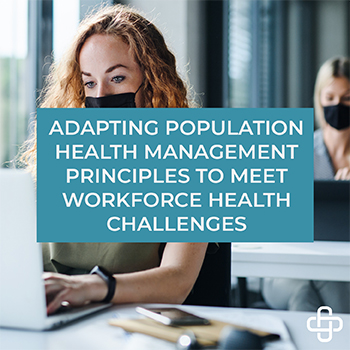 Traditionally, personal health and workplace health have been treated as strictly separate, each approached with different solutions and with very strong barriers to prevent any convergence… as Kipling wrote, “Oh, East is East, and West is West, and never the twain shall meet.”
Traditionally, personal health and workplace health have been treated as strictly separate, each approached with different solutions and with very strong barriers to prevent any convergence… as Kipling wrote, “Oh, East is East, and West is West, and never the twain shall meet.”
Several years ago, Axiom Medical began promoting the idea that this separation, created in the interest of protecting employees from discrimination on the basis of their health by guaranteeing the privacy of their personal health information, has many adverse unintended consequences. Notably, it exposes employees to higher risk of health incidents or injuries occurring in the workplace – and in this new COVID-19 era, it reduces the probability that employer policies around employee access to the workplace will be crafted to effectively protect those most vulnerable to severe consequences from infection.
Our perspective is that employers should adopt a ‘total worker health’ approach, focused on reducing occupational risk through personal health issues, and on improving the general wellness of the entire workforce. This approach could be described as Workforce Population Health Management (WPHM).
Population Health Management can be defined as an holistic approach that seeks to improve the general health of a population, usually a community, through a combination of data, analysis, targeted intervention, and preventive wellness initiatives. In the public health world, the advent of the Affordable Care Act resulted in strong incentives to healthcare providers to focus on improving the general health of the communities they serve. I see COVID-19 providing a similar level of impetus towards WPHM.
There are a few barriers to overcome before WPHM initiatives can be implemented.
- Objectives have to be clearly defined.
- Component solutions have to be identified.
- Comprehensive change management and communication plans have to be created.
- Policies have to be created that respect the legal boundaries established to protect personal health information.
- The trust of the workforce has to be earned.
As an example, an objective might be to reduce workplace injury accidents. Data suggests that tiredness, stress or personal illness can be contributory factors that increase the propensity for injury. Solution components may include biometric data collection devices, and a data monitoring service, that identify individuals at risk. Change management and communications initiatives might include education of the workforce around the linkages between workplace injury and these factors, and explanations of how participation in a monitoring plan would enable injuries to be reduced without adversely impacting any employee identified through monitoring as being at risk. Policies may include employee waivers, privacy guarantees, and enhanced PTO offerings. Trust may be earned through all of the above, and enhanced by engaging a third party to actively monitor the biometric data and identify at-risk individuals and trigger accommodations such as PTO or temporary changes of duty without sharing the details of the specific risk the employee is experiencing to the employer.
COVID-19 has provided a great testing ground for some of these measures, in the form of daily employee pre-screening for access to the workplace, followed by active case management of employees identified as exposed or actively symptomatic. Workforces generally have been very receptive to these measures in the context that they definitely don’t want to become infected, or spread infection themselves, in the workplace. Federal government mandates around PTO for COVID-19 have helped employers who might otherwise have struggled with the financial implications of paid absence or modified duty, come to terms with doing the right thing.
Axiom has been right in the middle of all this since the beginning, as the first to market with a medical call center solution for exposed and/or symptomatic employee case management, and then the first to market with a pre-screening app that flags potentially exposed and/or infected employees for secondary call center screening prior to permitting access to the workplace.
Some of our more forward thinking clients for these WPHM solution elements are now working with us to extend them to other aspects of employee personal health in the workplace.

Mark Robinson is the President and CEO at Axiom Medical. Connect with him on LinkedIn.
Find out more about our Injury Case Management services or our Occupational Health Programs.










